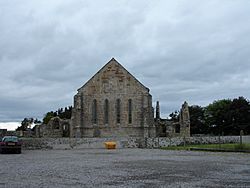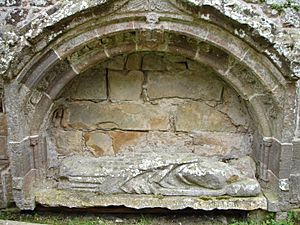Fearn Abbey facts for kids
 |
|
| Monastery information | |
|---|---|
| Order | Premonstratensian |
| Established | 1238 |
| Disestablished | 1609 |
| Mother house | Whithorn Priory |
| Diocese | Diocese of Ross |
| Controlled churches | Kilchrist, Tarbat |
| People | |
| Founder(s) | Fearchar, Earl of Ross |
| Important associated figures | Finlay McFaed |
Fearn Abbey, also called "The Lamp of the North," is one of Scotland's oldest church buildings. It's part of the Church of Scotland and is located southeast of Tain in Ross-shire. The old building stopped holding church services in 2023. Now, services and meetings happen in the modern church hall next door. In 2024, the church parishes of Fearn, Nigg, Tarbat, and Tain joined together. They are now called the Easter Ross Peninsula Church of Scotland.
Contents
The Abbey's Design
Fearn Abbey has a very simple design. It is shaped like a long rectangle, measuring about 96 feet long and 26 feet wide inside. The windows are tall and narrow, called lancet windows.
Main Church Building
At the eastern end of the church, there are four tall lancet windows. Similar windows appear in pairs between the buttresses, which are supports along the walls. The eastern part of the church was separated to be a burial place for the Ross of Balnagown family.
Chapels and Additions
Over time, other small chapels were added to the main church. The most important addition was the south wing, a chapel dedicated to Saint Michael. Abbot Finlay McFead, who died in 1485, likely built this chapel. It is about 32 feet long and 23 feet wide. It connects to the main church through a wide archway.
Inside this chapel, there is a doorway on the west side. On the east side, there is a small recess called an ambry. On the south side, you can see a special monument for Abbot Finlay. It shows his family shield and an old Latin message. The message says: "Here lies Finlay McFaed, abbot of Fearn, who died in the year 1485."
Another small chapel was built around the 1500s, blocking two windows. Another chapel was also built against the north wall. The cloister (a covered walkway) and other buildings where the monks lived are no longer standing. You can still see a deep groove worn into the stone wall. This was made over centuries by the rope of the church bell.
A Look at History
Medieval Times
Fearn Abbey was first started during the time of King Alexander II. It was founded by a group of monks called Premonstratensians from Whithorn Priory. These monks, also known as "white canons," provided the first abbot.
The Abbey was first set up by Fearchar, the 1st Earl of Ross, in the 1220s. But in 1238, it was moved about ten miles southeast. This move happened during the time of the second abbot, Malcolm of Nigg. The Abbey was moved because of problems with local clans. Also, the new location had richer soil, which was good for farming. The earls of Ross owned the land and protected the Abbey for many years.
In 1321, a monk named Mark became the abbot. He was chosen by the leader of Whithorn, not by the other monks. In 1338, William III, Earl of Ross ordered the Abbey to be rebuilt. This work was finished in 1372 by Abbot Donald Pupill. Many improvements were made during the 44 years that Abbot Finlay McFaed was in charge (1442-1485). A cloister was added, and the Abbey received an organ, special cabinets for holy items, cups, and robes from Flanders.
The Reformation Era
In the early 1500s, a young boy named Patrick Hamilton became the leader of the Abbey. Hamilton later believed in the ideas of the Reformation. He was burned as a heretic in 1528 when he was only 26 years old.
In 1539, King James V asked Pope Paul III to make Robert Cairncross, the Bishop of Ross, the abbot of Fearn. Cairncross was a wealthy man, and the king hoped he could fix the Abbey buildings, which were in bad shape. After Cairncross died in 1545, Nicholas Ross became the abbot. He was also a leader at the church in Tain. He likely held this position as a secular role, meaning he wasn't a monk. He even voted in the Parliament in 1560 to end Catholicism in Scotland.
After the Reformation
In 1587, the Abbey's lands were taken back by the Crown. The Abbey was then given to Patrick Gordon in 1591. In 1598, King James VI made Fearn into a special area called the barony of Geanies. Later, in 1609, it became part of the diocese of Ross for Bishop David Lindsay. This was confirmed by Parliament in 1617.
Even after the Reformation, Fearn Abbey continued to be used as a local church. However, a terrible accident happened in 1742. The stone roof collapsed during a church service, and almost 50 people died. A new church was built nearby, but it also fell into disrepair by the 1770s. So, in 1772, part of the original ruined Abbey was rebuilt. It became the parish church again, part of the Protestant Church of Scotland.
Recent Times
The church building you see today mostly dates from the 1772 rebuilding. However, it still includes parts of the medieval structure. It was repaired by Ian G. Lindsay & Partners in 1971. More restoration work happened in 2002 and 2003 with help from Historic Scotland. The people of Fearn Abbey are involved in community work. They also have strong connections to the Church of Scotland's projects in Ekwendeni, Malawi, and the Tabeetha School in Israel.
Important Burials
Many important people are buried at Fearn Abbey. Besides Abbot Finlay McFaed, some others include:
- Fearchar, the 1st Earl of Ross, who founded the Abbey. He died in 1251.
- Sir Mark Ross, an Abbot of Fearn Abbey, who died around 1350.
- Thomas Ross, a church leader who lived in Forres for many years because of problems with local barons. He died in 1591.
- General Charles Ross of Balnagown, a respected military leader during the time of King William III and Queen Mary II. He died in 1732.
- Sir John Lockhart-Ross, an Admiral in the Royal Navy. He died in 1790.
See also
- Abbot of Fearn, for a list of the Abbey's leaders
- List of Church of Scotland parishes


